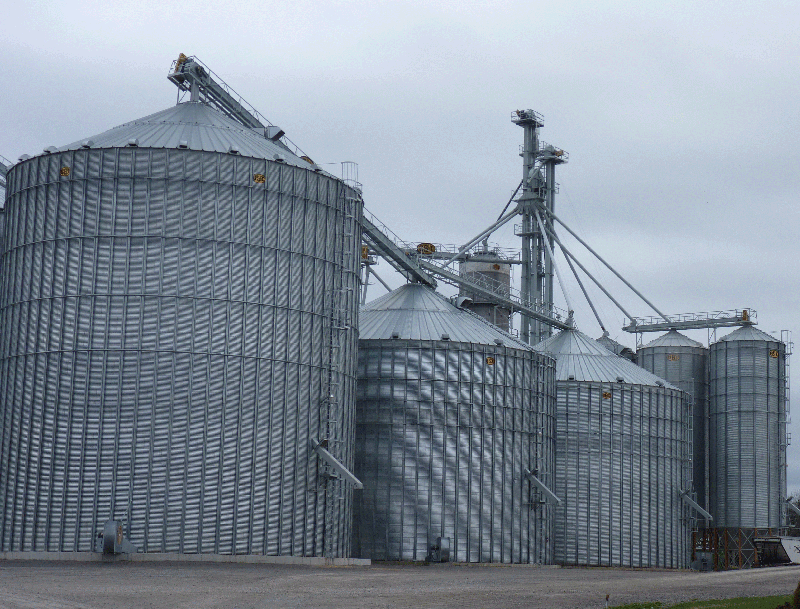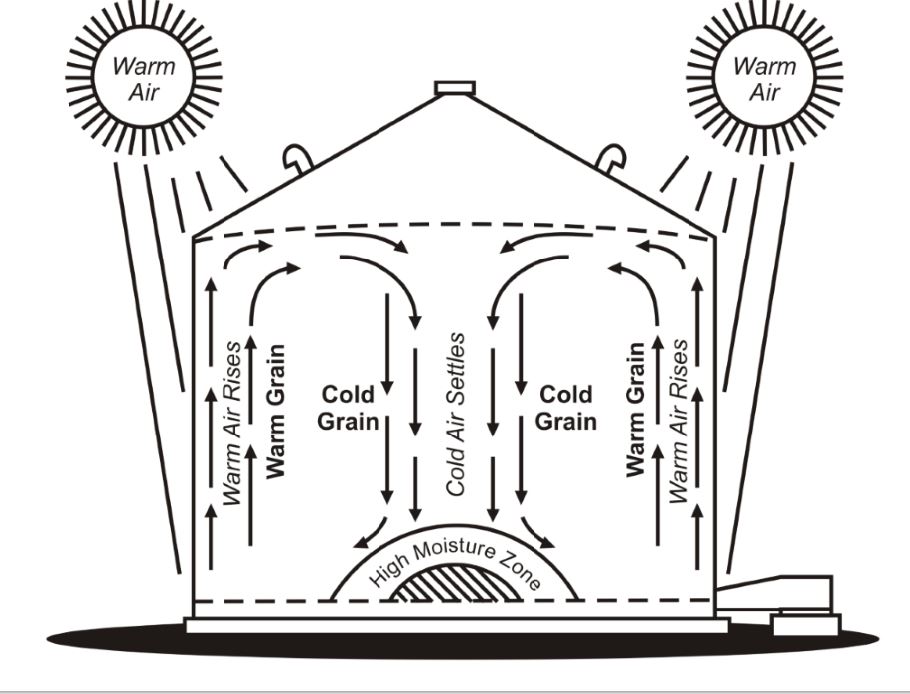Storing grain safely
HOW TO KEEP GRAIN IN GOOD CONDITION LONG-TERM

in these uncertain times, farmers putting grain into a bin may be considering storing that grain a bit longer than they had originally expected. If you are in that situation, there are a few steps to take which will help you store your grain long-term in good condition.

ENSURE GRAIN IS DRY
When it comes to storage, for any length of time, keep grain cool and dry to prevent spoilage. Diseases, moulds, and insects thrive in warm and wet conditions. For long-term storage (longer than six months), dry the grain an additional one to two points below “normal” storage moisture, to provide additional protection against spoilage.
If grain is slightly wetter than desired, an aeration fan can be used effectively for small amounts of drying. A commercial grain dryer may not be practical or efficient to remove a small amount of moisture. Drying depends on the outdoor air conditions. Using the Equilibrium Moisture Content (EMC) chart for the correct grain, look up the outdoor temperature and humidity, and find the corresponding grain moisture level.
You can also use BINcast, an online tool which provides a five-day hourly weather forecast (temperature and humidity) as well as a predicted EMC for your grain. To use BINcast, register for a free account at www.weathercentral.ca/, then choose “BINcast” from the menu. Find your location on the map, and a weather forecast and predicted moisture content will be generated for your chosen grain type. This is a great way to plan ahead, as you can see the full week’s forecast to know if weather conditions will be suitable for drying.
Run the fan whenever the moisture level in the EMC chart or on BINcast is below the actual moisture of the grain. As a rule of thumb, relative humidity below 65 – 70 per cent humidity usually provides good drying conditions. Turn the fans off whenever the humidity climbs, to avoid adding moisture back into the grain. Eventually, the grain will dry down, although this can take several weeks. If the aeration fan is very small, move the grain to a bin with a larger fan to speed up the drying process.
AERATE GRAIN REGULARLY
Aeration accomplishes three goals:
• Maintain grain temperatures for long-term storage.
• Equalize moisture throughout the bin
• Prevent convective air movement within the bin.
In the fall, as the air cools off, so will the metal wall of a grain bin, which will in turn cool the grain near the wall. With warmer grain in the centre of the bin, air will start to move inside the bin from warm to cold areas. This air movement will pull moisture from the grain and cause condensation in the attic space, creating a high-moisture area at the top of the bin. Watch for visible condensation inside the attic space of the bin — this moisture has come from the grain itself. Use aeration to keep the entire grain mass at a consistent temperature, and prevent moisture movement within the grain mass.
Over winter, grain can be cooled to or below freezing (0° C). Grain at this temperature can be stored safely for long periods, even if the moisture is a little higher than desired. In most situations, freezing grain to extremely cold temperatures does not provide additional benefit, unless the grower believes there is a high risk the grain may have an insect infestation. Freezing grain to -10° C or below can be an effective strategy to deal with certain insect pests, although the level of mortality will depend on the species of insect and the duration of the freezing temperatures.
In the spring, as the weather warms up and the sun shines on the side of a grain bin, the metal wall will heat up. This causes the opposite effect from the fall; heat will transfer to the grain near the wall, but the grain in the centre of the bin will still be cold from winter storage. The warm grain heats the air around it, which beings to rise and picks up moisture from the grain. The warm air begins to cool once it reaches the attic space, and falls through the centre of the bin, and its moisture condenses on the cold grain. A high-moisture area eventually forms at the bottom centre of the bin. This area is out of reach of monitoring, and will create problems when unloading the bin.
To reduce convective air movement, maintain the grain temperature within 5° C to 10° C of the average weekly outdoor air temperature, by running the aeration fan regularly. During very warm months, try to keep grain temperatures below 10° C if possible — in general, the risk of spoilage from convective air movement is lower than risk of spoilage from higher temperatures. Even through the summer, average daily low temperatures in the low-to-mid-teens are common, making night-time aeration a good option.

MONITOR YOUR BINS
If your bins have temperature and moisture monitoring cables, check them frequently. Many modern systems can send alerts to your computer or mobile device, if the temperature or moisture level begin to increase.

Over winter, watch for condensation in the attic space of the bin. This means you have unrestrained air movement within the grain and may have wet spots forming. Aerate to bring the grain mass to a constant temperature and dry out any higher-moisture pockets.
Physically check your bins once a week, once daytime temperatures exceed 10° C. Climb each bin, open the hatch and look visually for signs of spoilage. Are there indications of insects/mould? Is the grain bright, or is it dusty/dull? How does the grain smell? Your nose can quickly tell you what your eyes might miss.
If there are any signs of spoilage, move the grain out of the bin as quickly as possible. Monitor the grain as it is being unloaded. If the spoilage is contained to one area of the bin, you may be able to separate most of the “clean” grain.
With a bit of planning and careful management, high-quality grain can safely be stored long term. Aeration is the primary tool to keep grain dry and in good condition.
This article was originally published at www.fieldcropnews.com. •


























